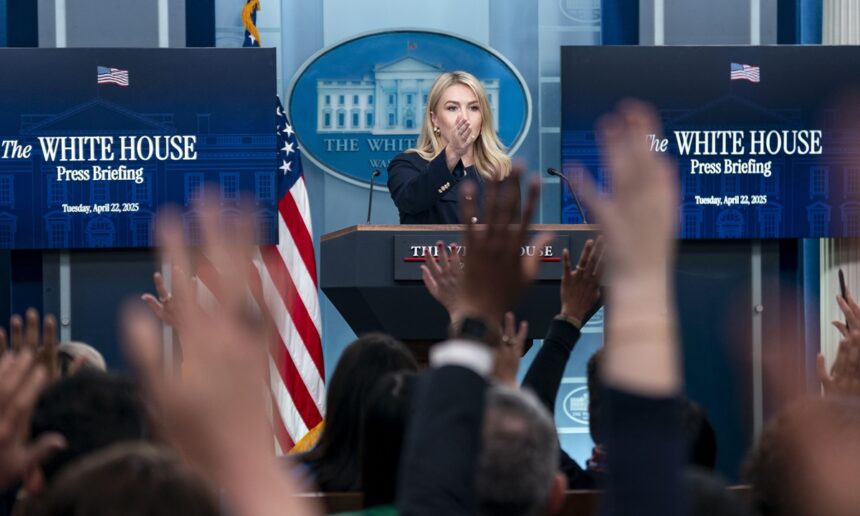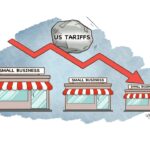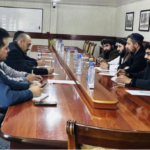By GT staff reporters
In a shifting media landscape in the US, “The AP (Associated Press) is on the outs, but these new MAGA (“Make America Great Again”) media stars are on the rise,” as noted in a recent article by US-based magazine Politico.
Political communication in the US appears to have undergone big changes since the new administration took office, and these changes are still unfolding. Earlier this month, the White House revised its system for the daily press corps covering President Trump’s activities, eliminating the fixed positions traditionally held by mainstream media outlets such as The AP.
This may not have been a sudden or hasty decision. In January, White House Press Secretary Karoline Leavitt announced the opening up of the briefing room to “new media voices” – independent journalists, podcasters, social media influencers, and content creators – to apply for credentials to cover the White House. The current administration made this move to “adapt this White House to the new media landscape in 2025,” said Leavitt, according to the White House website.
In addition to the White House, several US government departments, including the Department of Defense, are actively embracing new media by increasingly offering reporting opportunities that were traditionally reserved for mainstream outlets to internet influencers. Observers said that encouraged by US authorities, these influencers, particularly the conservative “MAGA” supporters, are gradually stepping into the spotlight and becoming a significant force in the US media landscape, influencing and even reshaping political communication in the country.
The deprofessionalization of political communication is becoming increasingly evident in the US, said experts reached by the Global Times. That may exacerbate the post-truth phenomenon, deepen societal divisions, and undermine both the effectiveness and credibility of democratic institutions, said Diao Daming, a professor at the School of International Studies, Renmin University of China.
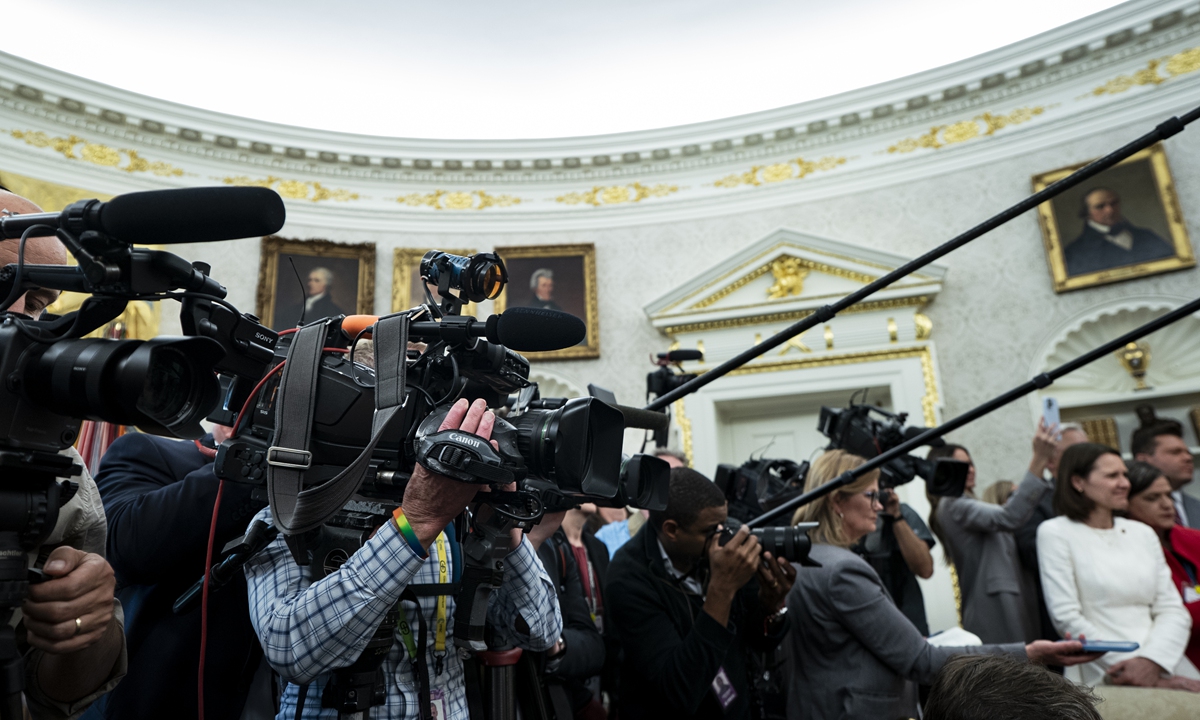
Picture shows media members in the Oval O ce of the White House in Washington D.C. on April 24, 2025. Photo: VCG
‘It’s hurting us big time’
On April 15, a White House official formalized “pool” criteria in a memo, and pointedly omitted a spot for wires, even though wire services like The AP are foundational to White House coverage, CNN reported the day after. In practice, this means major wire services, such as The AP, Reuters, and Bloomberg, will have markedly less access than they did in January, when all three were in the pool every day, read the CNN report.
According to the report, the “pool” refers to a “press pool” consisting of a small group of journalists, who travel with the US president and cover events on behalf of the entire White House press corps. Members of this pool are decided by a rotation system, and in the past, wire services like The AP have basically always been in the pool.
In a response to the change, The AP said in a statement that the White House’s move disregards “the fundamental American freedom to speak without government control or retaliation.” Furthermore, it called the action “a grave disservice to the American people,” Reuters reported.
This was not the first time in recent months that The AP was snubbed by the White House. In February, for instance, a credentialed AP reporter was prevented from entering a news conference. Also in the same month, its reporter and photographer were barred from boarding the presidential airplane for a weekend trip with the president, according to The AP.
The White House retaliated against the news outlet for not following the president’s executive order to rename the Gulf of Mexico, said The AP in a March 28 article. An internet search revealed that, the repeated denial of access to AP journalists by the White House is now one of the most frequently reported upon stories by The AP itself in recent months.
“It’s hurting us big time,” said AP photographer Evan Vucci, who was quoted by CNN. “We’re basically dead in the water on major news stories.”
Earlier, some mainstream media reporters stationed at the Pentagon experienced similar situations. The US Department of Defense announced on January 31 that it would institute a new “annual media rotation program” for its in-house press corps, removing several major news outlets, including NBC News, The New York Times, National Public Radio (NPR), and Politico, from their Pentagon office spaces in favor of other outlets, reported the NBC News.
NBC News reported that the positions vacated by mainstream media outlets would be rotated, and the Pentagon would select “one each from TV, print, radio, and online news to swap in and out.” The new entrants included One America News Network, the New York Post, and Breitbart News Network, most of which are conservative, it added.
Those being kicked out complained about their opportunities to report official voices being reduced. NBC News said it was “disappointed by the decision” by the Pentagon, as the change presented significant obstacles to its ability to gather and report news in the nation’s public interest. NPR, which was also excluded, stated that the decision “interferes with the ability of millions of Americans to directly hear from Pentagon leadership.”
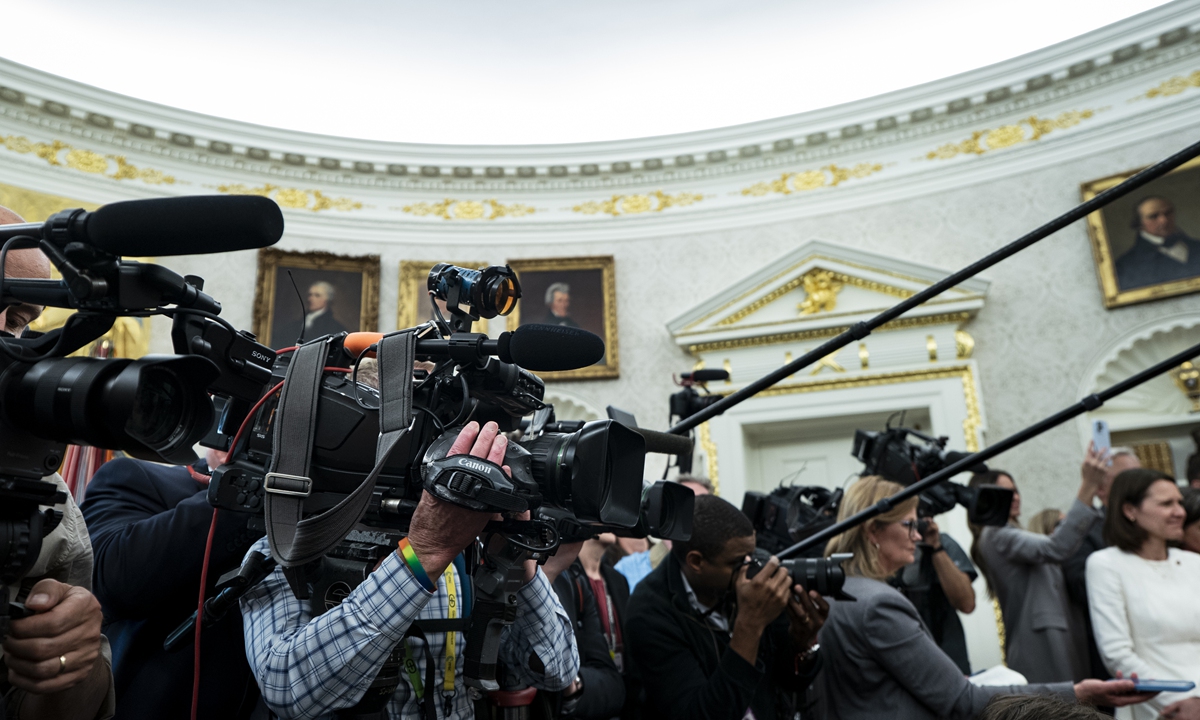
Picture shows media members in the Oval Office of the White House in Washington D.C. on April 24, 2025. Photo: VCG
Influencers take the stage
Within just one day after Leavitt announced that the West Wing of the White House (the location of the president’s office) would open the briefing room to members of “new media,” the White House received more than 7,000 applications for press passes, The Hill reported. Encouraged by the current administration, a large number of influencers have flocked to the White House and various major government departments, becoming, to some extent, “official” reporters and even part of the official communication agenda.
In an article titled “Meet the 8 MAGA outlets disrupting the White House briefing room” on Politico, the author introduced eight new media reporters, broadcasters, and social media influencers that have been frequently seen at the White House recently. Natalie Winters, for instance, is a 24-year-old co-host of the podcast “War Room” on social media. Self-described as a “populist nationalist,” Winters often delivers off-the-cuff monologues that pillory Democrats and sometimes her fellow reporters, according to The York Times. Her podcast, “War Room,” was described as a “top spreader of misinformation” by think tank Brookings Institution, which made this conclusion in 2023 after analyzing more than 36,000 podcast episodes, reported The Wall Street Journal.
Some influencers have gone even further. Graham Allen, host of the “Dear America” podcast who denies climate change and spreads conspiracy theories, such as claiming that “climate change is yet another attempt of the left to spin fear” on X, was appointed as a top communications official at the US Department of Defense, Politico reported.
The Washington Post remarked that the White House has “transformed its traditional press shop into a rapid response influencer operation,” as an increasing number of “new media” personnel, likely with clear political biases, continue to flood in.
Importantly, the influencers are reshaping the sources from which US audiences, particularly the youth, obtain their news. According to a study by the Pew Research Center in 2024, 37 percent of US adults under 30 said they regularly get news from influencers on social media, while 77 percent of news influencers are not affiliated or have a background with a news organization.
Although the White House’s direct engagement with online influencers to disseminate information helps broaden public awareness of relevant issues, these influencers often lack an in-depth understanding of the actual situation, which may result in unprofessional reporting, unclear analysis, and biased stances, said Diao.
“When such content spreads on social media, its oversimplification effect can further reinforce misinformation, exacerbating the ‘post-truth’ phenomenon, where emotions and personal beliefs take precedence over facts, making it harder for the public to discern the truth,” he told the Global Times.
The unchecked participation of numerous new media creators in news reporting may lead to an increase in fake news, said Shen Yi, a professor at the School of International Relations and Public Affairs at Fudan University.
“Although traditional media still has competitive advantages, such as fact-checking and debunking rumors, the US journalism industry will undoubtedly become even more polarized due to this trend,” Shen told the Global Times. “Ultimately, the information disseminated by such media accounts will gradually lose credibility among audiences.”
Meanwhile, young people in the US are increasingly obtaining news through social media platforms, and they are more susceptible to believing falsehoods. The aforementioned Pew study revealed that a fifth of US adults reported “regularly” receiving their news from online “news influencers” who post about current events, with this figure rising to nearly 40 percent among young adults aged 18 to 29. Meanwhile, a 2024 study by the University of Virginia indicated that, this age group struggles more to identify fake news, compared to those aged 65 and older.
Impact US democracy?
Inviting influencers to the White House press briefings is likely to usher in a new era of fake news, said The Conversation, an Australia-based news website. Moreover, the presence of influencers “is likely to undermine public regard for journalism in general,” it said. “This could sow even greater mistrust in the US media, which is already at record lows.”
The US public’s respect for professional news work has significantly eroded over the years. A poll published by Gallup in February showed that, US people’s trust in the mass media was at its lowest point in more than five decades, with only 31 percent of the people being surveyed trusting the media “a great deal” or “a fair amount.”
“One major reason why many people in the US distrust traditional media is the long-standing lack of transparency and perceived political bias. That aside, the Trump administration’s frequent attacks on mainstream media have further shaped people’s negative views toward these outlets,” Shen said.
Diao said that the public in the US, particularly the current administration’s base such as blue-collar and lower-middle-class voters, currently holds low trust in many traditional media outlets. “They see these traditional media outlets as overly liberal, elitist, and disconnected from conservative values, failing to adequately address the concerns of ordinary citizens. This distrust reflects the broader rise of anti-establishment sentiment in American society in recent years.”
Many are therefore left wondering whether the deprofessionalization of political communication will lead US democracy toward greater openness or plunge it into chaos. As political discourse shifts from professional media to algorithm-dependent news influencers, and as simplistic slogans replace complex political debates, this trend could have a negative impact on US democracy, according to Diao.
The White House’s moves to curtail journalists’ abilities to do their jobs and document what’s happening “is unprecedented,” said Katherine Jacobsen, US program director of the Committee to Protect Journalists.
However, for the influencers who have sat in the White House briefing room, these may not be the issues they need to consider. Instead, they may prioritize metrics such as public attention, and a sense of “revenge” against traditional media outlets that have long dominated political communication.
According to Politico, Winters enjoys going to the White House briefing room because it offers her a front-row seat to ground zero of the resistance, which is the media. “I’m not there to cover the White House. I’m there to cover the resistance forces,” she said.
“As the public increasingly relies on influencers for information, political polarization may worsen. Supporters become more entrenched in their views, opponents grow more hostile, and societal consensus becomes harder to achieve,” Diao told the Global Times.
“The blurring of truth could deepen social divisions, intensifying conflicts between different groups, and eroding public trust. Such fragmentation could undermine the effectiveness and credibility of democratic system.”




